At the Surface Navy Association's (SNA) 2018 National Symposium held last week near Washington DC, no less than five shipbuilders were showcasing their conceptual designs or parent designs for the U.S. Navy FFG(X) Frigate program.
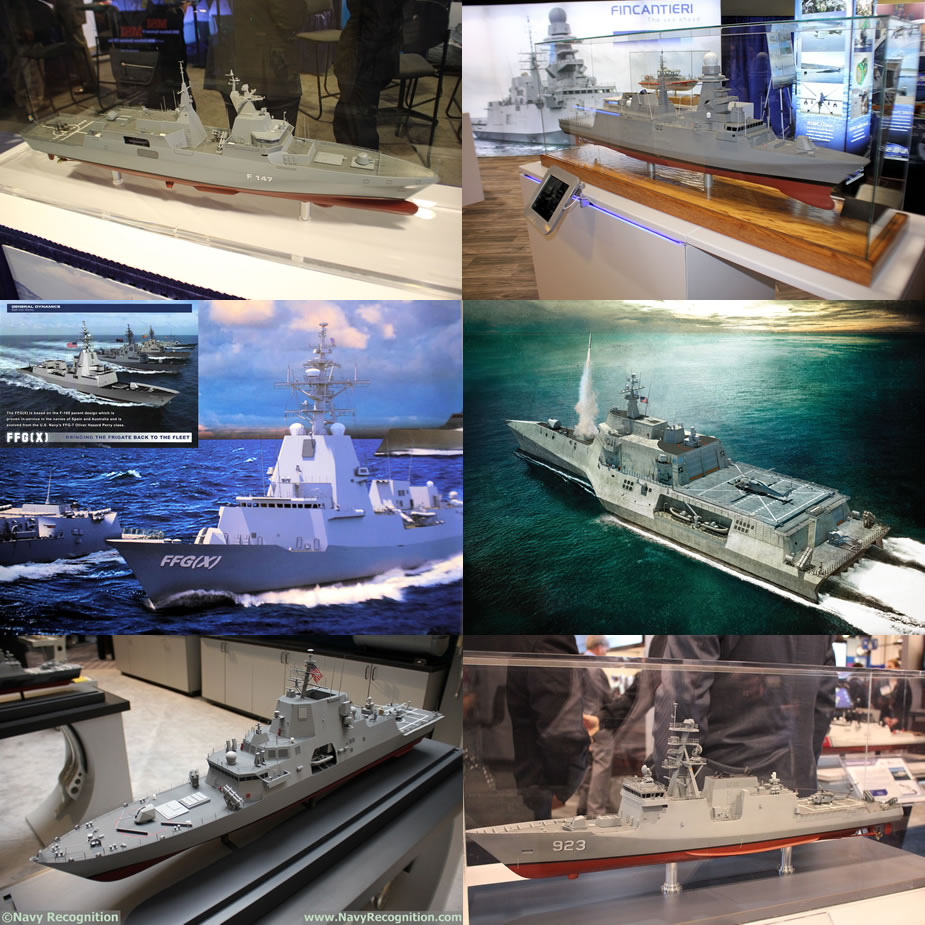 The FFG(X) contenders as seen at SNA 2018 (note: HII Patrol Frigate on the bottom right was NOT on display at the show).
The FFG(X) contenders as seen at SNA 2018 (note: HII Patrol Frigate on the bottom right was NOT on display at the show).
The US Department of Defense released a Request for Information (RFI) in July 2017 to let the industry know what the U.S. Navy is expecting from the FFG(X) Frigate. The RFI said, "A competition for FFG(X) is envisioned to consider existing parent designs for a Small Surface Combatant that can be modified to accommodate the specific capability requirements prescribed by the US Navy."
The U.S. Navy wants a frigate that can keep up with carrier strike groups as well as conduct missions on its own. “The FFG(X) will normally aggregate into strike groups and Large Surface Combatant led surface action groups but also possess the ability to robustly defend itself during conduct of independent operations while connected and contributing to the fleet tactical grid.” The U.S. Navy expects the frigate to be survivable in complex scenarios: "FFG(X) will perform its missions in complex electronic warfare and anti-ship missile threat environments".
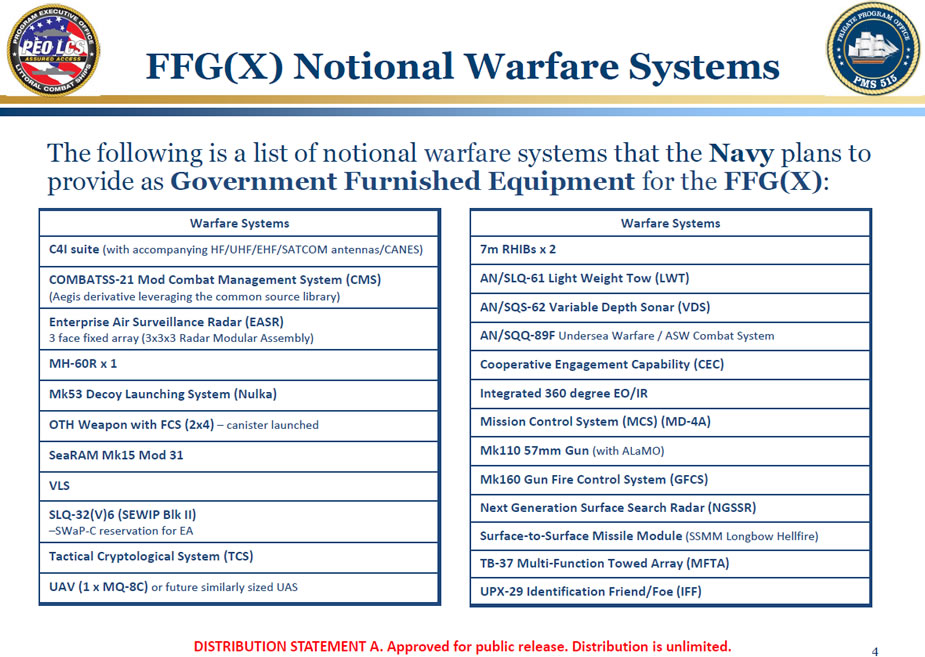 Slide from the FFG(X) briefing at SNA 2018
Slide from the FFG(X) briefing at SNA 2018
During SNA 2018, Dr. Regan Campbell, program manager for the Frigate Program Office (PMS 515) gave an FFG(X) program update.
FFG(X) is an agile, multi-mission platform designed for operation in littoral and blue water environments. Its missions are set to be Anti-Submarine Warfare, Surface Warfare, Electromagnetic Maneuver Warfare, and Air Warfare. FFG(X) will operate independently or integrated with a Task Force to conduct offensive and defensive Surface, Anti-Submarine, and Air Warfare.
According to the program manager, evolving threats in the global maritime environment drove the U.S. Navy to re-evaluate Frigate requirements and pursue a guided missile Frigate. FFG(X) leverages the proposed capabilities of the original Frigate (FF) program while adding:
• Increased Air Warfare (AW) capability in both self-defense and escort roles
• Enhanced survivability (specifically focused on reduced vulnerability)
• Increased Electromagnetic Maneuver Warfare (EMW) capability
Maximizing capabilities while balancing cost
• “High / Low” mix of surface combatant capabilities to meet the increased challenges of future operating environment
To reduce program risk for Detail Design & Construction (particularly with regard to the integration of warfare system elements and cyber architecture) common U.S. Navy systems will be used (EASR radar, COMBATSS21 combat system, C4ISR systems...) and launcher elements (Mk41 and SeaRAM) while encouraging hull, mechanical, and electrical system commonality with other US Navy platforms. Mature parent designs (ship design that has been through production and demonstrated at sea) are required to produce the most cost effective and capable designs to meet FFG(X) requirements
The program manager explained that Conceptual Design Proposals have now been received, with an award expected in late second quarter FY2018 (probably around March 2018): Four to six conceptual design development contracts will be selected. The current schedule calls for an RFI to be issued in the fourth quarter of FY2019 (summer 2019) with a downselect to a single source scheduled for FY2020.
The U.S. Navy intends to award a Detail Design and Construction contract for the first FFG(X) in 2020, the second ship in 2021 followed by the third and fourth ships in 2022. The "per hull cost" is expected to be $950 millions on average for 20 Frigates in the class.
While the program manager didn't want to mention which shipbuilders submitted their conceptual designs, here is an overview of what we saw (and heard) on the show floor at SNA 2018:

Atlas North America, the US branch of Atlas Elektronik, based on Yorktown, Virginia, was showcasing a MEKO A-200 with their partner ThyssenKrupp Marine Systems (TKMS). It has to be noted that Atlas Elektronik became a wholly owned subsidiary of ThyssenKrupp Marine Systems in 2017.
We learned at SNA 2018 that Atlas North America and TKMS have partnered with U.S. shipyard VT Halter Marine in Pascagoula, Mississippi for local production of the frigates. They have also partnered with the Columbia Group in order to adapt the MEKO A-200 parent design to the U.S. Navy requirements.
The MEKO A-200 is a proven design as it has been selected both by the South African Navy (4x Valour-class frigates) and the Algerian Navy (2x El Radii-class frigates). According to TKMS, The MEKO A-200 is a fighting ship capable of full 4-dimensional warfare (AAW, ASW and ASuW, BCW). It was designed for sustained operations across the full spectrum of general missions and tasks: patrol and interdiction, support of special force operations, SAR and humanitarian operations.
Basic specification of the baseline configuration/parent design (from TKMS website):
Length:. 121.0 m
Beam: 16.3 m
Draught: 4.4 m
Displacement: 3,700 t
Top speed: >29 knots
Range: 7,200 nm @16 knots
Crew: 100 to 120 sailors (+50)
 Austal rolled an updated design of its "Austal Frigate" at SNA 2018, reflecting some of the Government Furnished Equipments to be supplied by the U.S. Navy such as Raytheon's EASR radar. Note that the Mk41 VLS have been moved to the bow and stern and the number of anti-ship missiles have been reduced to 8x from 16x. You can easily compare with the earlier design reflected in the picture below. (Austal image).
Austal rolled an updated design of its "Austal Frigate" at SNA 2018, reflecting some of the Government Furnished Equipments to be supplied by the U.S. Navy such as Raytheon's EASR radar. Note that the Mk41 VLS have been moved to the bow and stern and the number of anti-ship missiles have been reduced to 8x from 16x. You can easily compare with the earlier design reflected in the picture below. (Austal image).
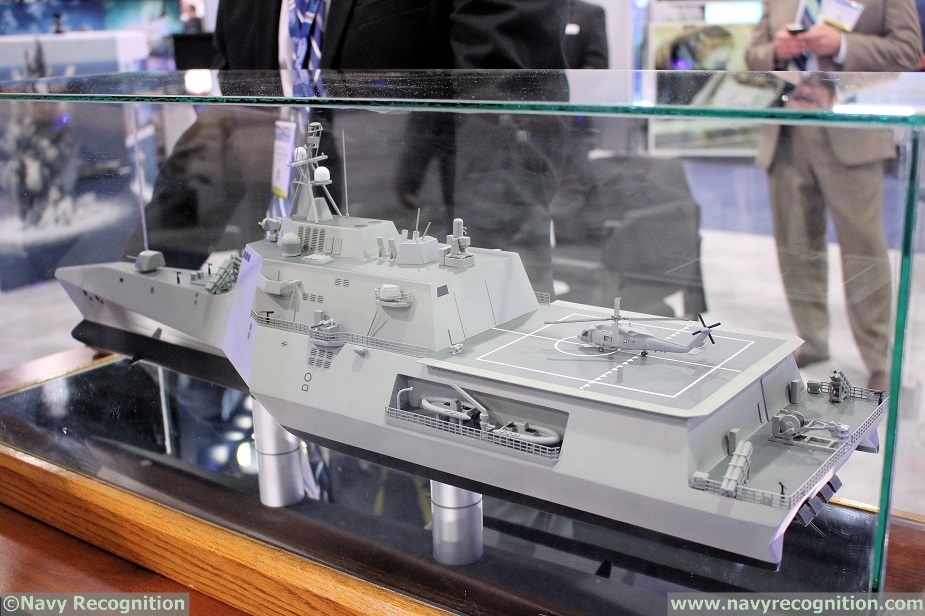
Austal "Austal Frigate"
Austal USA was showcasing the same scale model of the "Austal Frigate" which was rolled out last year at Sea Air Space 2017. But the Alabama-based shipyard showed us a poster (and brochures) showing an updated design reflecting the latest requirements from the U.S. Navy for FFG(X).
Compared to the Independence-class LCS (on which it is based), the "Austal Frigate" main modifications consist in a slightly shortened flight deck in order to fit anti-ship missile launchers and a variable depth sonar in order to add capabilities to the ship's aft. Compared to the early design unveiled last year, the latest design show that the 16x Mk41 VLS have been moved forward (just ahead of the bridge) and aft (at the edge of the flight deck). They used to placed on each side of the mast. The new design is fitted with Raytheon EASR radar as expected. The Remote Weapon Stations have been removed as there is currently no requirement for them. The newest design still shows the Thales CAPTAS-4 as the variable depth sonar. We were told this is to show that the Austal Frigate can accommodate the heaviest sonar option. The U.S. Navy still has to select the VDS for FFG(X). A Curtiss Wright / Raytheon VDS was selected for the LCS ASW mission module.
If selected for FFG(X), the Austal Frigate would be built at Austal USA's shipyard in Mobile, Alabama.
The (updated) Austal Frigate brochure reads: The Austal Frigate possesses increased lethality and high-speed shallow draft multi-mission combatant capabilities on a seaframe nearly identical to the Independence-variant Littoral Combat Ship. This ship’s ability to meet and exceed current US Navy requirements makes it one of the most cost-effective,maneuverable and flexible ships in the fleet.
Basic specification of the Austal Frigate (from Austal brochure):
Length:. 127.7 m
Beam: 31.7 m
Draught: 4.5 m
Displacement: 3,500 t
Top speed: >32 knots
Range: 4,300 nm @12 knots
Crew: Up to 130 sailors
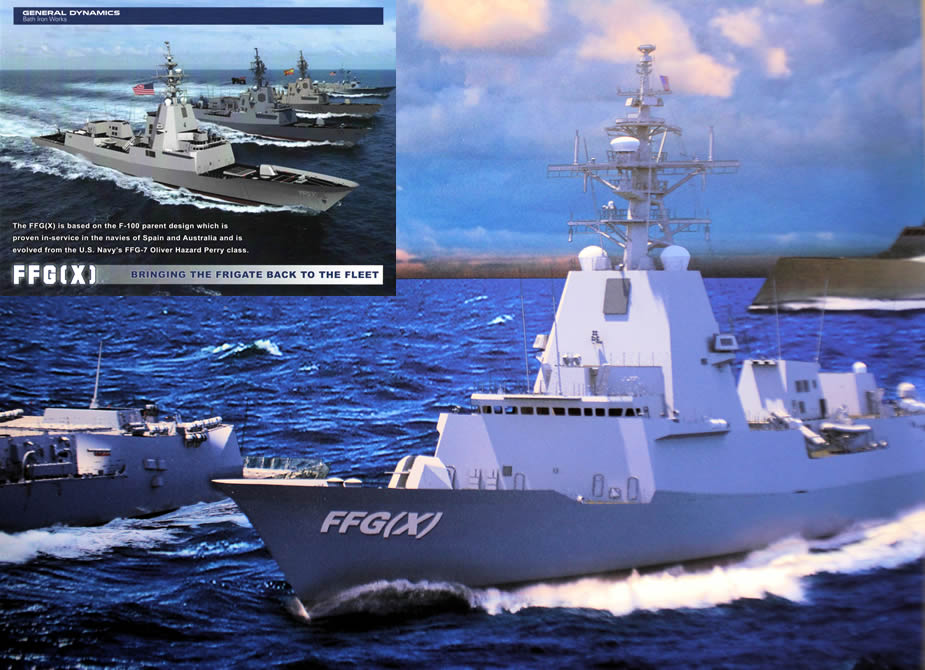 Artist impressions from a poster (main image) and brochure (trop left) showing General Dynamics Bath Iron Works' FFG(X) design at SNA 2018. The frigate is based on Navantia's F100 Frigate design. (GD BIW images).
Artist impressions from a poster (main image) and brochure (trop left) showing General Dynamics Bath Iron Works' FFG(X) design at SNA 2018. The frigate is based on Navantia's F100 Frigate design. (GD BIW images).
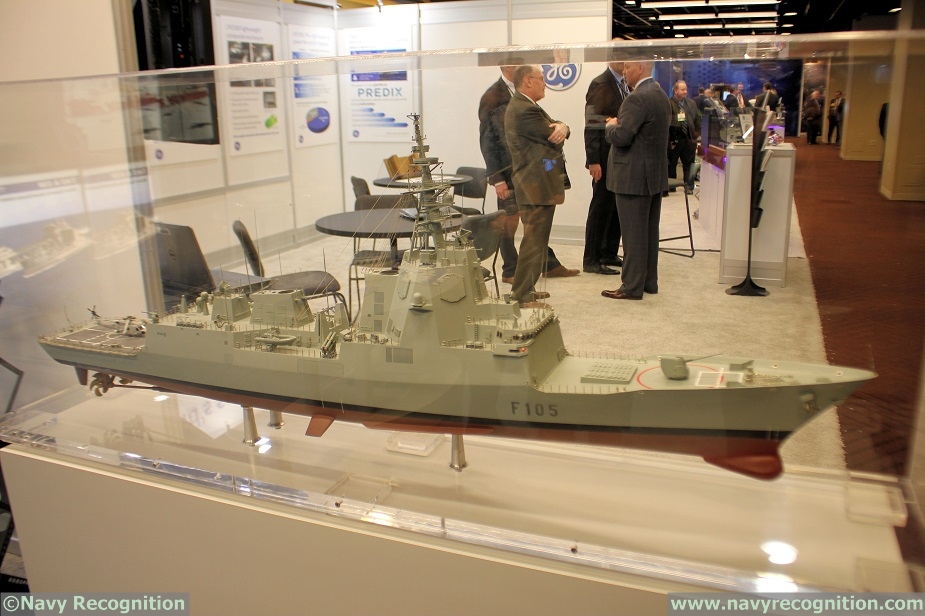 General Dynamics Bath Iron Works stand at SNA 2018 had a scale model of the Spanish Navy Álvaro de Bazán-class frigate Cristóbal Colón (F105) on display.
General Dynamics Bath Iron Works stand at SNA 2018 had a scale model of the Spanish Navy Álvaro de Bazán-class frigate Cristóbal Colón (F105) on display.
Bath Iron Works (General Dynamics) / Navantia "F100"
General Dynamics Bath Iron Works (BIW) was showcasing a scale model of the Spanish Navy Álvaro de Bazán-class frigate Cristóbal Colón (F105). They also had a poster and brochures showing the F100 design adapted to the FFG(X) requirements. Nobody from BIW could discuss the design with us however. We were just handed a brochure and pointed to the model and poster.
BIW is partnering with Spanish shipbuilding group Navantia as well as with Raytheon. Their conceptual design is based on the F100 frigate design. CGIs on the poster and brochure show an F100 hull fitted with a Raytheon EASR radar and a Mk110 main gun matching the U.S. Navy requirements. The BIW brochure reads: The FFG(X) is based on the F-100 parent design which is proven in-service with the navies of Spain and Australia and is evolved from the U.S. Navy's FFG-7 Oliver Hazard Perry class. F-100 is the ideal parent ship for FFG(X):
- Proven interoperability with US Navy carrier strike groups
- Already meets US Navy standards for survivability, combatant design features and material selection
- High system compatibility with US Navy.
If selected for FFG(X), those frigates would likely be built at BIW shipyard in Bath, Maine.
Basic specification of the baseline configuration/parent design (from Navantia F100 brochure):
Length:. 146.7 m
Beam: 18.6 m
Draught: 4.75 m
Displacement: 5,900 t
Top speed: 28 knots
Range: 4,500 nm @18 knots
Crew: Up to 234
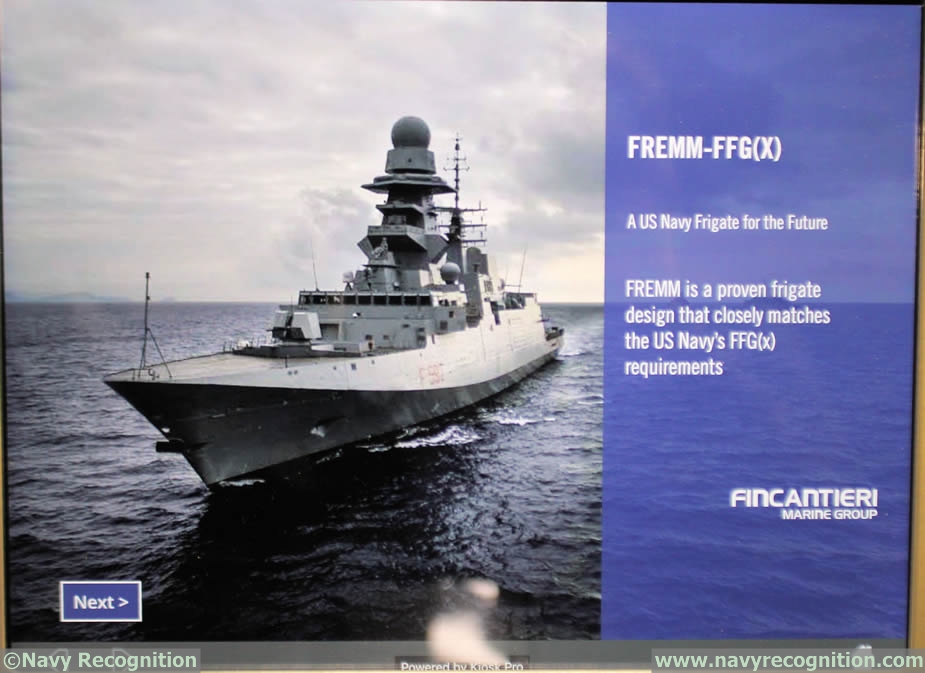 Fincantieri Marine Group stand had a tablet giving some quick facts about the FREMM.
Fincantieri Marine Group stand had a tablet giving some quick facts about the FREMM.
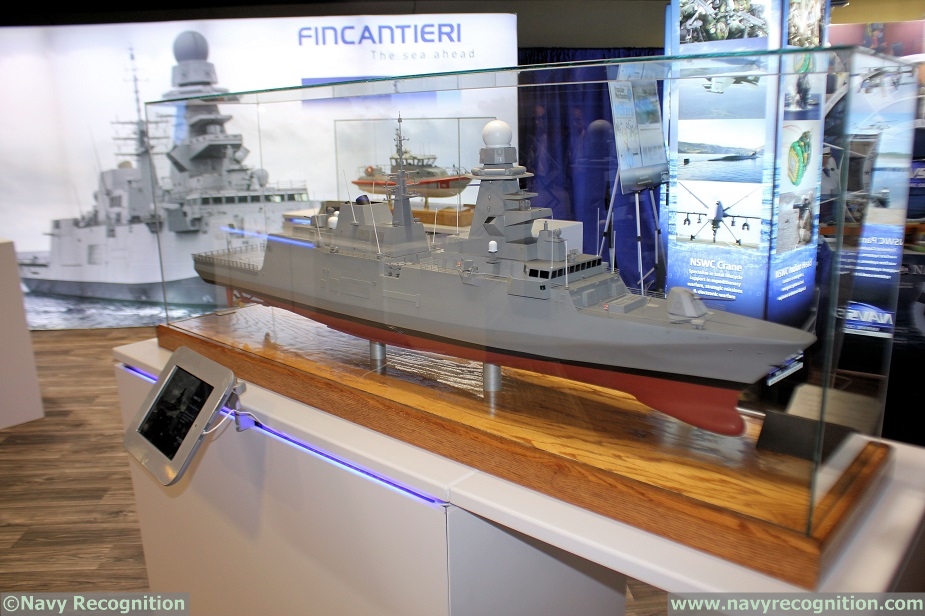 Fincantieri Marine Group stand at SNA 2018 featuring an Italian Navy FREMM scale model and backdrop.
Fincantieri Marine Group stand at SNA 2018 featuring an Italian Navy FREMM scale model and backdrop.
Fincantieri Marine Group / Fincantieri "FREMM"
Fincantieri Marine Group (FMG) and its parent company Italian shipbuilding group Fincantieri were activelly promoting the FREMM at SNA 2018. On display were a scale model of a "General Purpose" (Carlo Bergamini-class) FREMM of the Italian Navy, a large backdrop with the Virginio Fasan "ASW" FREMM (Italy has ordered six general purpose variants and four anti-submarine variants), a tablet with information and videos on the design as well as brochures.
FMG is partnering with US companies Gibbs & Cox and Trident Marine Systems.
The Fincantieri brochure reads: Fincantieri is offering FREMM, the most capable and modern frigate in service as the parent hull design for the U.S. Navy's FFG(X).
- 6 FREMM alread in service with the Italian Navy
- Over 30,000 hours and 200,000 nautical miles underway performing real world operations
- Design that has completed construciton 7 times
Fincantieri has assembled an experienced U.S. team (including Gibbs & Cox, and Trident Marine Systems) to carve the ideal path to adapt FREMM to US design standards, while not compromising how FREMM already meets or exceeds all top level thresholds of the FFG(X) requirements.
If selected for FFG(X), the "American FREMM" would be built at Fincantieri Marinette Marine in Marinette, Wisconsin.
Basic specification of the baseline configuration/parent design (from FREMM FFG(X) brochure):
Length:. 143.8 m
Beam: 19.8 m
Draught: 5.48 m
Displacement: 6,500 t
Sustained speed: 26.5 knots
Range: 6,000 nm @15 knots
Crew: 133 (+77)
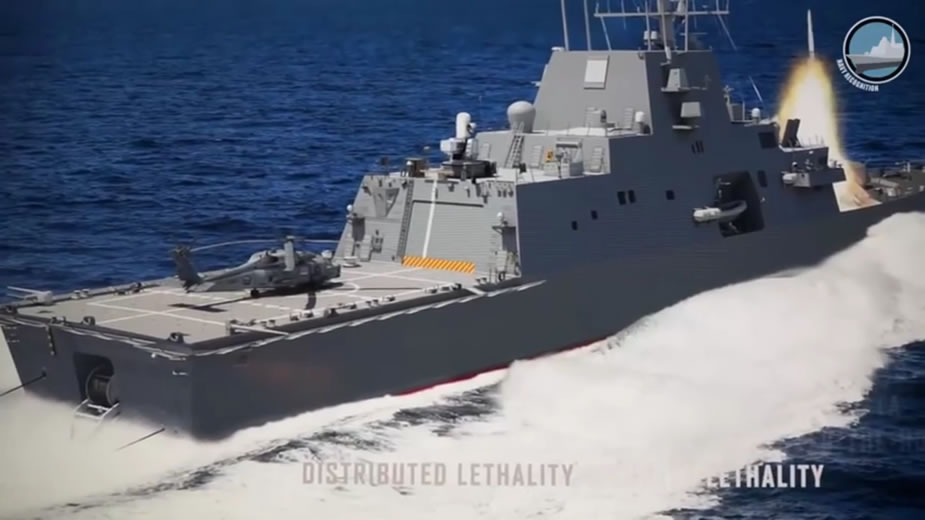 Lockheed Martin stand had a large screen showing an artist impression of its "Freedom-Variant" Frigate.
Lockheed Martin stand had a large screen showing an artist impression of its "Freedom-Variant" Frigate.
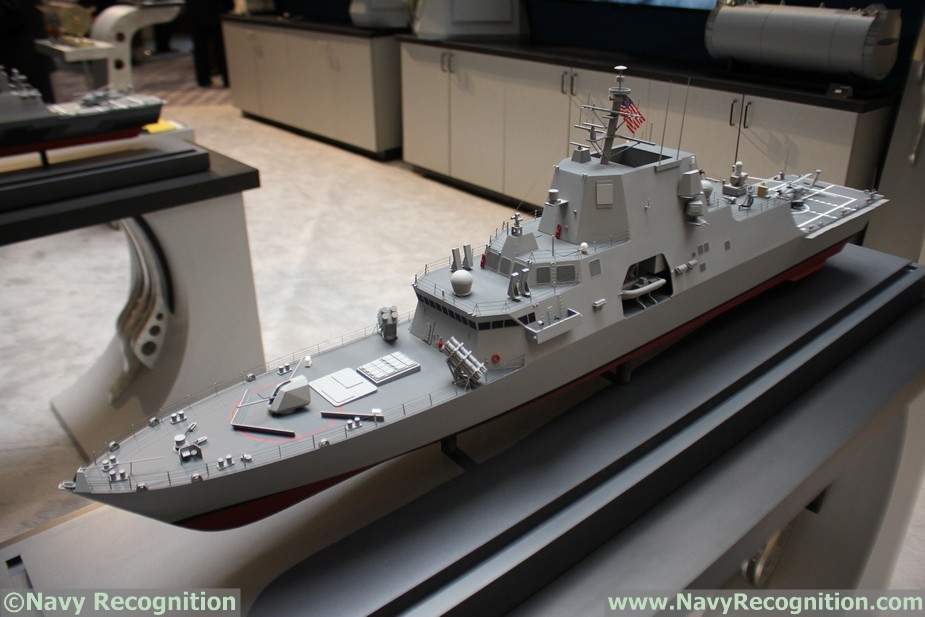 Lockheed Martin "Freedom-Variant" Frigate unveiled at SNA 2018.
Lockheed Martin "Freedom-Variant" Frigate unveiled at SNA 2018.
Lockheed Martin "Freedom Frigate"
The main attraction of the show this year (as far as we are concerned): Lockheed Martin was the only exhibitor at SNA 2018 to unveil the design of the frigate it is proposing for the U.S. Navy FFG(X) requirement. Unfortunately everyone was tight-lipped on the Lockheed Martin stand. And there was no brochure to give us some basic specifications on the "Freedom Frigate".
Lockheed Martin latest Frigate design is based on the Freedom-class Littoral Combat Ship (LCS). It is our understanding that this frigate uses the 125 meters hull of an earlier design unveiled at DSEI 2017 (for comparison, the LCS measures 115 meters in length). We were told during DSEI 2017 that the crew complement of the 125m vessel was 130 sailors (compared to a crew of 65 sailors on the LCS). Compared to the Freedom-class, the bridge and superstructre of the frigate have been completely redesigned. The bridge face is less slanted / more vertical and the superstructure forms three steps, the last one being significantly higher. This is to accommodate Raytheon's Enterprise Air Surveillance Radar (EASR). For more details about the design you can read our Freedom-Variant Frigate story at this link or watch our video coverage on YouTube.
Lockheed Martin is partnering with Fincantieri Marinette Marine and Gibbs & Cox.
A dedicated Freedom-Variant frigate page published on Lockheed Martin website for SNA 2018 reads: With rapidly evolving threats, world markets need to confront different types of bulls and bears. That’s why Lockheed Martin is evolving its Freedom-variant ship design to confront modern threats to maritime and economic security. The Freedom-variant Frigate offers planners and commanders the strength and affordability needed to rapidly rebuild the U.S. Navy fleet and guarantee freedom of the seas for decades to come.
- Strong solution: With an American-made steel hull, our ship is ready to provide presence around the world for the U.S. Navy.
- Strong team: Anchored by the world’s leading complex systems integrator, we can deliver a lethal, capable and resilient ship.
- Strong economics: Our capable Midwestern ship yard and supply chain support over 12,500 jobs in 42 states.
If selected for FFG(X), the Freedom-Variant Frigate would be built at Fincantieri Marinette Marine in Marinette, Wisconsin.
Basic specification of the baseline configuration/parent design (based on our information from DSEI 2017):
Length:. 125 m
Beam: N/A
Draught: N/A
Displacement: N/A
Top speed: N/A
Range: N/A
Crew: 130 sailors

Our video coverage on HII Patrol Frigate at Sea Air Space 2014.
Huntington Ingalls Industries / Ingalls Shipbuilding "Patrol Frigate"
HII kept a very low profile at SNA 2018 and was NOT showcasing a scale model of its FFG(X) conceptual design (not even a poster or brochure of its Patrol Frigate unveiled several years ago) and nobody was willing to discuss the topic. However we learned from several sources that HII have indeed submited a conceptual design for FFG(X), so here is some information about their Patrol Frigate based on information available at previous shows.
Unveiled in 2012, HII Patrol Frigate is based on the National Security Cutter (Legend-class NSC) it is still building for the U.S. Coast Guard. Seven ships are already in service, one under construction and one on order.
An HII brochure on the Patrol Frigate at Sea Air Space 2017 read: The Patrol Frigate Guided Missile (PFG) is a lethal, capable and affordable small surface combatant based on a proven parent hull form. Optimized for Anti-Submarine Warfare, Anti-Surface Warfare and Anti-Air Warfare, the Patrol Frigate incorporates proven weapons systems that maximize combatant capabilities. With extensive range and endurance, the staying power of the Patrol Frigate provides exceptional capability to keep forces forward deployed. Utilizing an existing hull form allows for more efficient production and reduces non-recurring design costs putting ships into the fleet quickly and affordably.
Basic specification of the baseline configuration/parent design (based on HII brochure from 2017):
Length:. 127.4 m
Beam: N/A
Draught: N/A
Displacement: 4,617 tons
Top speed: >28 knots
Range: 8,030 nautical miles
Crew: N/A
Check out our video coverage from SNA 2018 on FFG(X) proposals from GD BIW, Atlas North America, Austal and Fincantieri below.
As mention previously you can find our video coverage of Lockheed Martin's Frigate design at this link.










